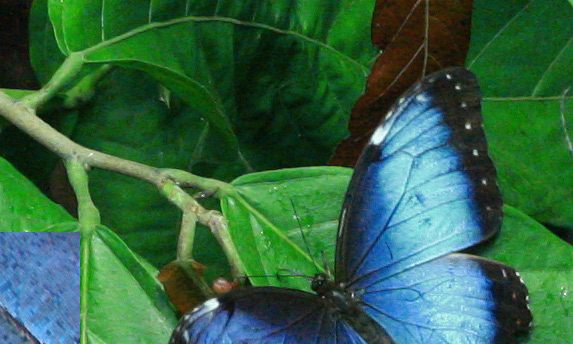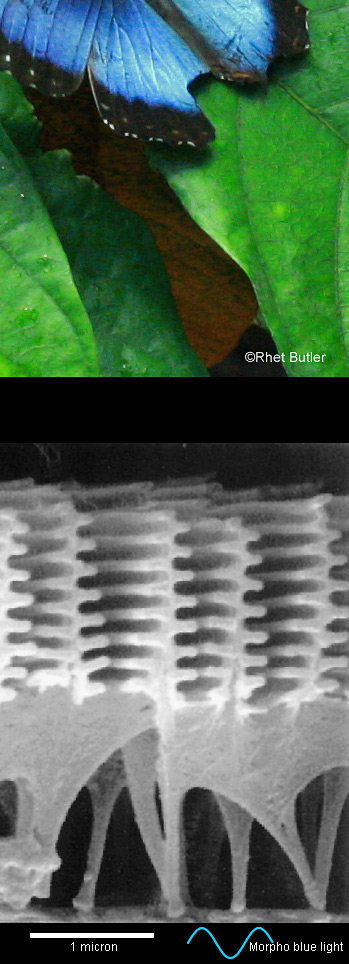 |
 |
|
 |
|
|
|
 |
|||
 |
||||
| Butterflies & Bookcases ~ A morpho butterfly with its intense blue wings is said to be visible up to a quarter mile away. Its colour properties are the product of astounding optical nano-structures. |
 |
 |
|
 |
|
|
|
 |
|||
 |
||||

| About - Submit | Optics Picture of the Day | Galleries | Previous | Next | Today |
Further reading: |
| 20,000X electron micrograph of a slice across an inner scale from Morpho rhetenor. The top has an array of parallel ridges each one like a library bookcase containing two sets of 7-10 shelves. The periodicity, staggered shelving and variations in bookcase height all contribute to the desired colour performance |
| The wing of a Morpho with its thousands of scales like a giant tiled roof. There are outer and inner (ground) scales. The inner ones generate the blue but both contribute to the overall optical performance |
| To say that Morpho bright colours are from iridescence is a deceptive simplification for Morphos are triumphs of optical engineering. Their wings are intensely bright with pure colour. Most importantly for long distance recognition, the intensity and colour is the same over a range of viewing angles and the light is polarized. Simple interference from a single or multiple layers cannot achieve this. Look at a soap bubble or an oil film � its colours are not very bright nor pure and they alter with viewing direction. How does Morpho do it? The wings are covered with two layers of scales like an enormous tiled roof. In general the inner or ground scales produce most of the colour effects. The ground scales are hollow and electron microscopy reveals intricate quasi-periodic structures. The top has a series of long parallel ridges each of which under high magnification is revealed as made up of a dual stack of parallel plates like two back to back library bookshelves. There are subtleties that are not accidental but have an optical purpose. The shelves on each side are staggered. The �bookcases� themselves have a careful random height variation. All this is on a nano-scale. For example, the shelves of Morpho Didius are spaced 200nanometres apart in height and are 50-70nm thick. For comparison, �Morpho blue� light has a wavelength of 460nm. Each bookcase is about 2000 nm tall with 7-10 shelves. Books would not stand upright because all the shelves tilt 7-10� along their length. The pure colour and high reflectivity come primarily from multi-layer interference as rays are reflected from successive shelves. Compare the effect with the blue colour from inside labradorite (earlier OPOD) generated by stacked silicate layers. |
| The Morpho blue is much more intense because the refractive index (~1.56) between the shelf cuticle and air is considerable and gives strong reflections. Multilayer interference alone is not enough. It would produce a less than useful reflection varying in colour and intensity with changing direction. The staggered shelf positions and bookcase heights help destroy the coherence of the outgoing waves and reduce speckle, bright diffraction spots and the angular dependence. Diffraction from the periodic spaced ridges (bookcases) also broadens the angles over which the intense blue is seen and adds polarisation that could be important for long distance signalling and mating. |
| The outer cover scale acts in some species (e.g. M.Didius) by diffusing the incoming light and further reducing the blue reflection angular dependence. It (and the tops of the bookcases) also scatteres light and helps differentiate between species. Pigmentation plays a small role. The lower part of the ground scale can be melanin pigmented to reduce red and green light and thus increase the apparent brilliance of the interference generated blue. In total, an impressive piece of evolutionary optical engineering. Also a prime example of structural colour where a system’s optical properties derive from a complex nano-structure rather than from pigments. Not all butterflies employ such heights of optical sophistication but there are others. We see structural colour too in feathers, beetles, fish scales and even some plants. The stuff of future OPODs! |
 |
 |
 |
 |
 |
| Image credits: Morpho butterfly Rhet Butler - Mongabay.com shown with permission Morpho wing scales Dr Erica Bower Science Writer/ Interpretation Consultant/ Photographer - site shown with permission Morpho rhetenor ground scale electron micrograph Professor Shuichi Kinoshita Osaka University, Japan shown with permission |